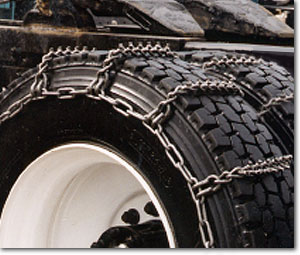
Colorado mountain drivers are a unique breed of trucker, requiring special skills to successfully handle driving on steep, mountainous terrain often covered in snow and ice. If you’re a truck driver normally traveling the flatlands, you carry chains on your rig as required by law, but you may have never actually used them. Many drivers prefer to pull over and wait for the roads to be cleared or find an alternate route to bypass snow-covered passes if possible. For dedicated Colorado mountain drivers, pulling over and waiting for improved road conditions isn’t an option.
To safely negotiate snow-covered mountain highways and provide reliable, timely delivery of your load, you need to know how to properly install your tire chains and, once chained up, how to adjust your driving technique to get where you’re going as safely and efficiently as possible. Proper chain installation requires some practice and should be done before the actual need arises, to ensure that, when the time comes, it can be accomplished quickly and without guesswork.
When and Where to Chain Up
Colorado State chain laws require all commercial vehicles driving on Interstate-70 between Dotsero (milepost 133) and Morrison (milepost 259), from September 1 to May 31, to carry the appropriate number of tire chains. When chain installation is required, signs will be posted as an indication. Semis with four drive wheels (or more) must have chains installed on four wheels. Laws don’t require chains to be installed on trailers. Chain-up areas are provided along the highways at different, posted locations.
Driving A Chained-Up Rig
It’s a misconception that if you’re running your rig with chains you have to slow to a speed 5 mph going downhill. Driving between 15-18 mph is safer and presents less likelihood of putting the truck into a jackknife than if you’re trying to hold back all that weight on a downgrade. It’s also easier on your brakes.
Driving in the proper torque range to keep adequate uphill momentum is critical. Keeping engine RPM between 1250-1300 will allow for steady momentum, which is key when driving uphill on snow and ice. Keeping your rig in the most efficient part of its torque curve (1200-1450) makes for less slippage and reduces the need for the tires to grip the road as much.
As a professional trucker, what chaining up tips do you have to share?
